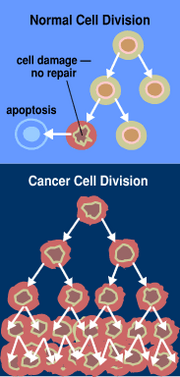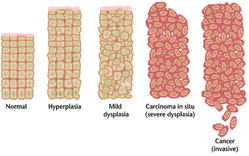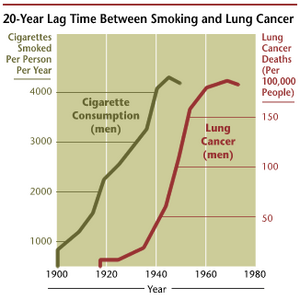Kendahl King is an actress, tall and gregarious, with a great pair of legs. She has two adorable children and a television-exec husband, Brett, who can't stop telling her how hot she is. She eats at trendy Los Angeles organic-food restaurants, goes to art openings and photo exhibitions, and, in true fabulous-Black-girl fashion, has a closet full of funky clothes and expensive shoes, which, she jokes, speak to her. "They get mad if I don't wear them." Most days Kendahl spins like a tornado--from the gym to an audition, from rehearsal to picking up the kids. She's funny and sarcastic, with lively eyes and skin that glows like a warm fire. Until last August her life was pretty well perfect. Then out of nowhere came the worst kind of trouble.
Kendahl discovered the lump on the side of her left breast just before going on a family vacation to Puerto Rico. She had just finished nursing her 1-year-old daughter, Logan, and at first she thought the lump was a clogged milk duct, something she'd had when she nursed her son. But this felt different: It moved when she pressed it. She didn't say anything to Brett because why should she worry him when it might be nothing? But as soon as they got home, she made an appointment for a mammogram.
Days later Kendahl waited with a handful of other women in the medical-imaging department of Cedars-Sinai Medical Center for her name to be called. One by one, women went for their exams and returned to the waiting room. And then one by one, they were told "everything looked fine" and they could go home. Everyone except Kendahl. "It was really eerie," she says. "It was just me alone in the room." Then a male voice in the corridor asked a technician, "Is Ms. King still here? Have you round a conference room to take her to?" Kendahl's heart dropped to her knees.
The radiologist said the lump in her breast was unusual. Instead of one mass, the X-ray showed a lump that had flowered out like a cauliflower. There were five distinct points; each would need to be biopsied. "How bad is it?" Kendahl asked. "I don't know," said the doctor. "I've never seen anything like it."
According to the National Breast Cancer Foundation, one out of eight women will develop breast cancer in her lifetime. But no woman envisions that it will happen to her--especially not when she, like Kendahl, is only 38. But if you're African-American, breast cancer is more likely to strike in the years prior to age 40 than if you're White. And once they are diagnosed, Black women are 32 percent more likely to die of the disease. The reasons for this are complicated: Not only do many African-American women receive substandard health care, but premenopausal Black women are more likely than others to contract one of the deadliest forms of the cancer.
When she first found the lump, Kendahl didn't know a lot about cancer, but she knew it might mean death, "Before they even knew what it was, I went to a really bad place," she remembers. "Things just flash in your mind like, Are the kids going to remember me when I'm dead? I even thought about what I was going to look like lying in my casket."
Two days later Kendahl was feeling good about an audition she'd just finished. She wasn't even thinking about her breast when the phone rang. "Kendahl," said her gynecologist, "if I tell you to come into my office, you'll know exactly what's going on, so I'm going to spare you the trip. The results weren't good." The doctor kept talking. There were appointments Kendahl would have to make, specialists to consider, but the words turned to garble in her ear. "I can't process this right now," she said. "I have to get to my car."
There is a name for the shock some people feel after they hear they have cancer: acute stress reaction. Most patients just say they went numb. In a daze, Kendahl wandered the labyrinth of corridors looking for the way out of the building where her audition had been held. She turned down one hallway and into another. All the doors looked alike. Her heart was pounding. She wanted to see her husband. And did the doctor just say cancer?
IN SICKNESS AND IN HEALTH
People have different ways of coping with cancer. Some women wail and moan and collapse in despair; others pray and turn to God; still others slip into denial, refusing treatment that could save their lives. Experts used to believe that a "positive attitude" could improve a woman's chance of combating the illness. But a few recent studies suggest that successful coping isn't necessarily about having a positive outlook. In fact, pushing women to be optimistic, when cheerful is not how they feel, can cause its own kind of stress. When faced with cancer, a worrier will worry and a complainer will keep complaining, but that doesn't mean their survival rates will be any worse. "You are who you are when you're diagnosed," says Karen Eubanks Jackson, founder and president of Sisters Network, Inc., a support and information center for African-American breast cancer survivors and their families. "Even so, from my experience, your health is better if you think you're going to live and especially if you think you're going to live well."
After her diagnosis, living well became Kendahl's number one priority. "First it hits you that you could die, and then it's, 'Yeah, I could die from this disease, but I could also get hit by a bus.' I figured I was going to go through this now, and it will be awful, but in the end I'll be exactly who I was. In fact, I'll go through this and when it's over, I'll be better than I was."
Because the lump was so unusual, Kendahl chose to fight the cancer as aggressively as possible, which in her case meant removal of both breasts (women who have a history of cancer in one breast have an increased risk of cancer in the other), then six rounds of chemotherapy and over a month of radiation. While many women find a mastectomy one of the most traumatic aspects of cancer, Kendahl insists that she wasn't too heartbroken about losing her breasts. After nursing two babies, she says, they were "gross and lopsided" anyway. She was even kind of excited about deciding how big her new reconstructed breasts would be. "The doctor told me to try different-size prostheses to get an idea," she says. "One day I went out with a C cup. When I came back to my car, someone had left me a little note on the windshield that said, 'You have great tits!'"
NO VICTIMS HERE
Kendahl was mostly intent on keeping some fun in her life. There was the "wake" for her breasts with all her girlfriends at her house a few days before the mastectomy, and a "bye-bye boobs" party in her hospital room the day of. During chemo there were dinner parties with everyone gathered in the living room while Brett played deejay. There were weekends away, just the two of them, and private dress-up parties when she'd throw on a Beyonce wig and high heels and prance around for her man. "We had a raucus good time," she says, laughing.
But it was still cancer, and some days were awful. Like the times when Kendahl and Brett would surfer in private trying to protect each other from their sadness--Brett having a meltdown, crying and throwing things around his office on a Sunday evening, Kendahl banging on her steering wheel and wailing at the sky. Or the times Kendahl's scalp would sting and burn, and then the next day her hair would fall out, or the nights when laying her head on the pillow was agony. Even now, months after Kendahl's last round of chemo, Brett's eyes fill with tears when he talks about the toll cancer took on his wife.
"I never really discussed this with her," he says, "but it was hard not to react when she had no hair, no eyebrows, no eyelashes, and her skin tone, which is normally unbelievable, was kind of grayish. She had no breasts, and these terrible scars." Brett's voice begins to crack, and he gets up to close the door to his office. "I used to have to come in and see her in the bathtub like that," he continues. "I didn't want to freak out or turn away, but to see my wife, who is not just attractive but stunning, to see her taken to that place was really difficult."
He adds, "At other times it wasn't difficult at all. I was just accustomed to it. So I'd wake up in the morning, look over and she'd be asleep, no hair, no eyebrows, but she was still my baby. She was still my girl."
Brett did what he could to make things better. Once he bought Kendahl a hot-pink wig that looked like something out of one of their favorite movies, Blade Runner, to wear to chemo. Another time he showed up at the hospital with a giant cake that had "f--cancer" written in icing.
Oddly, when you ask Kendahl and Brett what was the most difficult part for them about this past year, among the first things they mention are the reactions of other people: the sorrow from folks who demanded comforting, or the morbid sympathy cards with inscriptions like "God has a plan for everyone," which drove Kendahl crazy.
"They look like those cards you send when someone dies," she says. "It's like the printer decided, 'We got a run on those death cards, so let's make another batch of them for people with cancer, too.'" Brett and Kendahl realize that everyone means well, but when you're determined to live through cancer instead of dying from it, other people's grief is, well, hard to take.
STILL KICKING
August 27 marked the one-year anniversary of Kendahl's diagnosis. Like other women who have undergone a double mastectomy, chemotherapy and radiation, she now has an 80 percent chance of the cancer's never returning. With each year that passes, her chances of remaining cancer-free increase. Her life is a waiting game.
But you wouldn't know it to see her. Kendahl is still fabulous. She's got a recurring role on NBC's crime drama Medium and a recurring role on UPN's One on One, and she's back to designing jewelry. She is as effervescent as ever. "It's probably a really good thing this happened to me, because I gained such clarity about who is important in my life, what I don't need to put up with, what makes me happy," she says. "And I've learned not to feel guilty about the decisions I make to take care of myself. I'm not about bulls--anymore. When bulls--starts to happen, I just walk away. I'm more like a warrior now, a lioness."
At the back of Kendahl's closet are a pair of really expensive cowboy boots. "My cancer-kicking boots," she calls them. "I wore those a lot when I was going through treatment. I'm actually thinking about wearing them again, because they made me feel like a badass supermom who can do anything."
If boots really could talk, they would most certainly agree.
RELATED ARTICLE: Many faces, many choices.
Using chemotherapy, mastectomy and holistic treatments, sisters are confronting breast cancer with options as varied as their illnesses and lifestyles
JANELLE WHITEHEAD, SEATTLE
AGE DIAGNOSIS: 36 YEAR: 1999
TREATMENTS: MASTECTOMY, CHEMOTHERAPY, RADIATION
Janelle's mother died of breast cancer at 51. When Janelle felt a lump in her breast, the cancer had already spread to the lymph nodes and ducts. She chose a mastectomy and chemotherapy, but the cancer recurred in her lungs and bones. In stage four, with a terminal prognosis, Janelle continues chemo, but more important, she maintains a natural enthusiasm for life.
WILHELMINA GRANT, NEW YORK CITY
AGE AT DIAGNOSIS: 37 YEAR: 1994
TREATMENTS: LUMPECTOMY, RADIATION, MASTECTOMY,
TAMOXIFEN, HERBAL TREATMENTS
A blow to the breast during a karate session led this former model to doctors. They found a stage-two cancer that had spread to five lymph nodes. Wilhelmina relied on wheatgrass throughout her treatments; it made her feel better, if only psychologically. She felt informed by her research and empowered by her support network, and is responding well to treatment.
ANGELA ROBINSON, MEMPHIS
AGE AT DIAGNOSIS: 29 YEAR: 2003
TREATMENTS: CHEMOTHERAPY, PARTIAL MASTECTOMY, RADIATION
Angela was diagnosed with a rare and aggressive form of breast cancer. It has spread to her liver and bones, but she is fighting back. She uses milk thistle to cleanse the liver and CoQ10, an antioxidant, to help battle cancer cells. Though doctors won't confirm that the regimen helps, she is resting adequately, listening to her body's messages, and reacting well to chemo.
GWYNITA HILL, JACKSON, TENNESSEE
AGE AT DIAGNOSIS: 32 YEAR: 1999
TREATMENTS: LUMPECTOMY, RADIATION, TAMOXIFEN
Married only two years and eager to start a family, Gwynita discovered two painful lumps in her breast. Her doctor removed them; a biopsy later revealed that they were cancerous. Gwynita started radiation therapy and began taking tamoxifen but soon became pregnant Despite doctors' concern, she decided to carry the baby to term. Her son was born in 2001. Despite early health challenges, he is healthy and active; mom is well, too.
RELATED ARTICLE: A family of survivors.
"I am a survivor; I don't have time to play games," says Karen Eubanks Jackson of the no-nonsense approach she and the members of her organization, Sisters Network, Inc., take in assisting African-American women with breast cancer. "It's our mission to ensure that women and their families, spouses and friends get the services and information they need." If that means accompanying a woman to her doctor, telling her what to expect from chemotherapy, going over treatment options, or helping her find a good wig, the women from Sisters Network are there.
Sisters Network, Inc., has branches in 45 cities; (866) 781-1808 or sistersnetworkinc.org. For more information and resources, see "Outsmart Breast Cancer" in this issue.--J.A.
Jeannine Amber is a senior writer at ESSENCE. She wrote "The Joy of Sizzling Sex" for our September issue.
COPYRIGHT 2005 Essence Communications, Inc.
COPYRIGHT 2005 Gale Group




